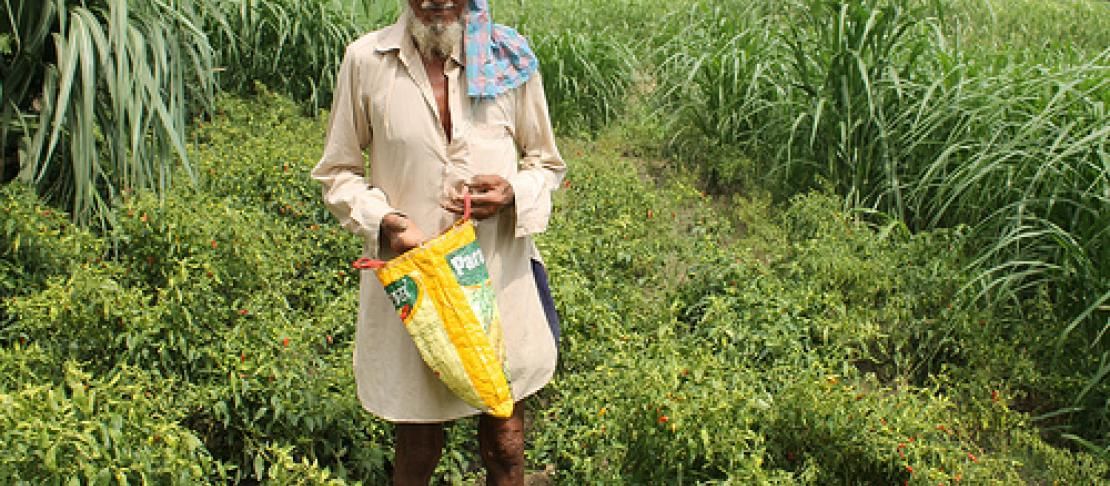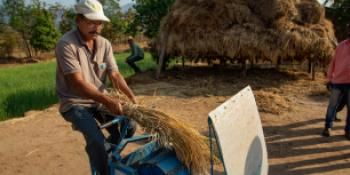New tool helps monitor crops in real time

Normal
0
21
false
false
false
DA
X-NONE
X-NONE
Normal
0
21
false
false
false
DA
X-NONE
X-NONE
/* Style Definitions */
table.MsoNormalTable
{mso-style-name:"Table Normal";
mso-tstyle-rowband-size:0;
mso-tstyle-colband-size:0;
mso-style-noshow:yes;
mso-style-priority:99;
mso-style-parent:"";
mso-padding-alt:0cm 5.4pt 0cm 5.4pt;
mso-para-margin:0cm;
mso-para-margin-bottom:.0001pt;
mso-pagination:widow-orphan;
font-size:10.0pt;
font-family:"Calibri","sans-serif";}
/* Style Definitions */
table.MsoNormalTable
{mso-style-name:"Table Normal";
mso-tstyle-rowband-size:0;
mso-tstyle-colband-size:0;
mso-style-noshow:yes;
mso-style-priority:99;
mso-style-parent:"";
mso-padding-alt:0cm 5.4pt 0cm 5.4pt;
mso-para-margin:0cm;
mso-para-margin-bottom:.0001pt;
mso-pagination:widow-orphan;
font-size:10.0pt;
font-family:"Calibri","sans-serif";}
To better adapt to increased climate variability, a system to help monitor crop-growing conditions in real time and make reliable yield forecasts, would be hugely valuable!
One such system has actually been developed, and it is the Regional Agricultural Forecasting Toolbox (CRAFT) for South Asia, a software platform launched in May in New Delhi, India of this year.
The Toolbox can help policy makers with providing precise information on the likely volume of crop production in specific areas at different times of the year. This will help to plan the necessary steps to address the food production situation. The use of this strategy will enable better management of agricultural risks associated with increasing climate variability and extreme events.
CRAFT is a flexible, adaptable, accessible software platform to support within-season forecasting of crop production, which also provides risk analysis and climate change impact studies and presents timely information to policy makers.
It provides support for:
- Spatial input data & spatial crop simulations,
- Integration of seasonal climate forecasts,
- Spatial aggregation and probabilistic analysis of forecast uncertainty,
- Calibration of model predictions from historic agricultural statistics,
- And, analysis and visualization.
It is currently based on Decision Support System for Agrotechnology Transfer (DSSAT) group of models that simulate the growth and development of 28 different crops, but this will be expanded to include more models.
Incorporated is a Climate Predictability Tool from the International Research Institute (IRI) in Columbia to support analysis based on weather forecast. The tool, developed by the CGIAR Research Program on Climate Change, Agriculture and Food Security (CCAFS) South Asia with the support of the Asia Risk Centre (ARC), supports the efforts of governments, policy makers and scientists to anticipate the impacts of climate variations on crop and rangeland production in support of agricultural management and food security decisions.
Read more about the software on the Asia Risk Centre News site.
CCAFS South Asia has been closely working with stakeholders in the region to enhance their capacity in yield forecasting and to bring together policy makers to inform them about the kinds of tools and techniques that would be helpful for them while planning and making decisions. Participants from Nepal, India, Bangladesh and Sri Lanka representing NARS, Ministries of Environment and Agriculture, NGOs and the CGIAR attended a workshop and worked on their country-specific studies to understand CRAFT’s structure and functions.
Though CRAFT has the potential to be applied in many South Asian countries, some tweaks still need to be made. For example, the traditional crop cutting method for yield forecasting is slow and information becomes available after harvesting and is often not precise.
As the information reaches policy makers long after harvesting, contingency measures could not be taken effectively. With CRAFT, information on in-season production starts coming in from the day the plants start growing and it is updated at regular intervals of time. By the time the crop reaches its maturity, the likely volume of production can be made available for planning.
Case studies will soon be undertaken in Nepal, India, Bangladesh and Sri Lanka to help fine-tune the toolkit and make it appropriate for each country. It will require a handful of data related to soil, crop varieties, area planted, agronomic practices, irrigation and historical weather information to precisely predict in-season yields. Researchers will continue to work on these country specific case studies to test the tool and to share information with policy makers that will improve the development of contingency plans.
A link to the CRAFT tool will be made available after conducting the case studies.
Learn more about our work on Data and Tools.
This story was prepared by Gopal D Bhatta, climate consultant for South Asia and Pramod K Aggarwal, Regional Program Leader South Asia. Learn more about what we do in South Asia. Sign-up for the South Asia e-newsletter to get the latest updates, found via this link to the right.
Normal
0
21
false
false
false
DA
X-NONE
X-NONE
Normal
0
21
false
false
false
DA
X-NONE
X-NONE
/* Style Definitions */
table.MsoNormalTable
{mso-style-name:"Table Normal";
mso-tstyle-rowband-size:0;
mso-tstyle-colband-size:0;
mso-style-noshow:yes;
mso-style-priority:99;
mso-style-parent:"";
mso-padding-alt:0cm 5.4pt 0cm 5.4pt;
mso-para-margin:0cm;
mso-para-margin-bottom:.0001pt;
mso-pagination:widow-orphan;
font-size:10.0pt;
font-family:"Calibri","sans-serif";}
/* Style Definitions */
table.MsoNormalTable
{mso-style-name:"Table Normal";
mso-tstyle-rowband-size:0;
mso-tstyle-colband-size:0;
mso-style-noshow:yes;
mso-style-priority:99;
mso-style-parent:"";
mso-padding-alt:0cm 5.4pt 0cm 5.4pt;
mso-para-margin:0cm;
mso-para-margin-bottom:.0001pt;
mso-pagination:widow-orphan;
font-size:10.0pt;
font-family:"Calibri","sans-serif";}



